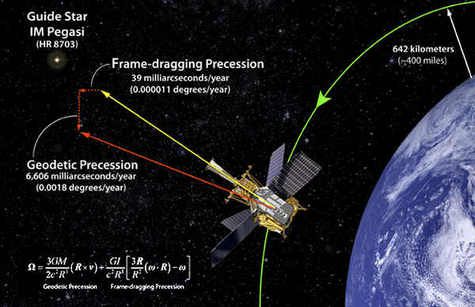-
 Pancreatic islet
Pancreatic islet
-
 Mamavirus
Mamavirus
-
 Miscible
Miscible
-
 Plasma membrane
Plasma membrane
-
 Kodiak bear
Kodiak bear
-
 Scambaiting
Scambaiting
-
 GPRS
GPRS
-
 Joule effect
Joule effect
-
 Vacuole
Vacuole
-
 Antibiotic
Antibiotic
-
 Haemagglutinin
Haemagglutinin
-
 Eczema
Eczema
-
 Androsterone
Androsterone
-
 Pseudo-random number
Pseudo-random number
-
 Brain death
Brain death
-
 Gliding
Gliding
-
 DBMS
DBMS
-
 MBR
MBR
-
 Clay
Clay
-
 Small Magellanic cloud
Small Magellanic cloud
-
 Hot-plug
Hot-plug
-
 Fish-eye
Fish-eye
-
 Non-spectral colour
Non-spectral colour
-
 Phosphorescence
Phosphorescence
-
 Big Bang
Big Bang
-
 Biogenic amine
Biogenic amine
-
 Galactose
Galactose
-
 Cillosis
Cillosis
-
 Undermining
Undermining
-
 Amylose
Amylose
Gravity Probe B
Gravity Probe B is an experiment using gyroscopes in space to test two predictions of Einstein's theory of general relativity. The satellite containing the gyroscopes was developed by NASA and Stanford University.
The satellite is in a polar orbit at an altitude of about 650 km. The gyroscope is composed of 4 quartz spheres covered with a layer of niobium. These spheres rotate and are cooled by liquid helium. In the absence of the effects of general relativity, their axes of rotation should remain fixed in space and point in the direction of a star, IM Pegasi.
The curvature of space-time that explains gravitation in general relativity, and the rotation of the Earth according to this same theory, will induce movements of these axes. The exact values of these shifts could either further validate Einstein's theory, or open the way to a theory of gravitation beyond general relativity. The two effects studied are the Einstein-De Sitter effect and frame dragging.
 Gravity Probe B
Gravity Probe B
Latest
Fill out my online form.



